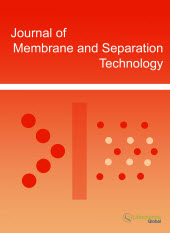jmst
Abstract : Ion Exchange Membranes for Electrodialysis: A Comprehensive Review of Recent Advances
|
|
Abstract: Electrodialysis related processes are effectively applied in desalination of sea and brackish water, waste water treatment, chemical process industry, and food and pharmaceutical industry. In this process, fundamental component is the ion exchange membrane (IEM), which allows the selective transport of ions. The evolvement of an IEM not only makes the process cleaner and energy-efficient but also recovers useful effluents that are now going to wastes. However ion-exchange membranes with better selectivity, less electrical resistance, good chemical, mechanical and thermal stability are appropriate for these processes. For the development of new IEMs, a lot of tactics have been applied in the last two decades. The intention of this paper is to briefly review synthetic aspects in the development of new ion-exchange membranes and their applications for electrodialysis related processes. Keywords: Electrodialysis, ion exchange membrane, anion exchange membrane, cation exchange membrane, bipolar membrane.Download Full Article |
Abstract : Divalent Transition Metals Substituted LaFeO3 Perovskite Catalyst for Nitrous Oxide Decomposition
|
|
Abstract: Divalent transition metals substituted LaFeO3 type perovskite catalysts (LaFe0.95M0.05O3 with M= Cu2+ and Ni2+) were synthesized by hydrothermal method and characterized by using X-ray diffraction (XRD), temperature programmed reduction with H2 (H2-TPR) and N2-physisorption techniques. The catalytic activity of the catalysts was tested for N2O decomposition reaction. Enhancement in the catalytic activity was observed after substitution of Cu and Ni metal ions into LaFeO3 framework. LaFe0.95Ni0.05O3 showed higher catalytic activity than LaFeO3 and LaFe0.95Cu0.05O3 catalysts. The plausible reason for the increased activity is that LaFe0.95Ni0.05O3 sample possessed high oxygen mobility than the other two samples. Keywords: Perovskite, N2O decomposition, Ni and Cu metal ions, XRD, H2-TPR.Download Full Article |
Abstract : Separation of CO2/CH4 through Carbon Tubular Membranes: Effect of Carbonization Temperature
|
|
Abstract: Carbon membranes have received much attention as advance materials in the gas separation technology due to their superior gas permeation performance and thermal and chemical stability. In order to increase the mechanical strength of the membrane, supported carbon membrane were produced using ceramic tube as support layer. Carbon tubular membranes were produced by carbonizing polymeric tubular membrane under different process parameter. In this study, carbon tubular membranes originating from Matrimid were prepared and characterized in term of its gas permeation properties. The preparation method involved dip-coating of the ceramic tubes with a Matrimid-based solution. The carbon tubular membranes were obtained by carbonization of the resultant polymeric tubular membrane under Argon gas flow in the horizontal tube furnace. The effects of the carbonization temperature on the gas permeation performance were investigated. Pure gas permeation tests were performed using CO2 and CH4 at room temperature with pressure 8 bars. The permeance and selectivity data indicate that the highest CO2/CH4 selectivity of 87.30 was obtained for carbon tubular membrane prepared at carbonization temperature of 850ºC. Keywords: Polymeric membrane, carbonization, carbon tubular membrane, separation, carbon dioxide.Download Full Article |
Abstract : Mitigating Low-Pressure Membrane Fouling by Controlling the Charge of Precipitated Floc Particles
|
|
Abstract: Fouling presents the most significant obstacle to optimal low-pressure membrane plant performance. The occurrence of fouling tends to decrease production rates (flux), increase chemical usage incurred during clean-in-place (CIP) process, increase energy costs, shorten membrane life and reduce recovery. Fouling may be of organic or inorganic nature, necessitating more frequent dual chemical cleaning procedures. Regardless of the nature of the foulants, particulate loading onto the membrane fiber surface has been identified as a common mechanism of deteriorating performance. Particulates and colloidal materials such as turbidity, natural organic material (NOM), algae and precipitated coagulant floc accumulate on the membrane surface and disrupt the laminar flow of water through the element. Particulates can either attach or adhere to the membrane surface through electrostatic attraction. One method of reducing this fouling mechanism is to employ controlled coagulation as a direct feed or coupled with a clarification step prior to membrane process. Coagulation can attract and retain naturally occurring particulates and colloidal materials via charge neutralization. Then, by controlling the charge of precipitated floc particulates to align with the surface charge of the membrane element, both types of fouling can be mitigated. This Paper summarizes two demonstrations featuring a pressure feed and a submerged vacuum ultrafiltration (UF) system. Keywords: Coagulant, Floc, Particulate, Flux, Electrostatic.Download Full Article |
Abstract : Development of Porous Asymmetric Polyamide–Imide Torlon® Membranes for Physical CO2 Absorption and Separation
|
|
Abstract: Porous flat-sheet polyamide–imide (PAI) membranes were prepared via a phase inversion method to evaluate CO2 absorption performance in the gas-liquid membrane contactors. Different amounts of polyethylene glycol (PEG-600) were introduced into the polymer solution to investigate the structure and performance of resulted membranes. The membranes were characterized in terms of gas permeation, contact angle measurement and CO2 absorption flux. By introducing 6 wt.% PEG into the polymer dope, N2 permeance of the membrane was significantly improved from 482 to 1320 GPU. Mean while, the effect of PEG on the measured water contact angle was in significant. From CO2 absorption test, the developed membrane presented about 90% higher CO2flux compared to the plain membrane at water flow rate of 70 ml/min. In conclusion, by introducing a polymeric non-solvent additive into the polymer dope, it is possible to enhance surface porosity (permeability) of PAI membranes, which is a key factor for CO2 absorption test. Keywords: Polyamide-imide membrane, non-solvent additive, CO2 absorption, membrane contactor.Download Full Article |


